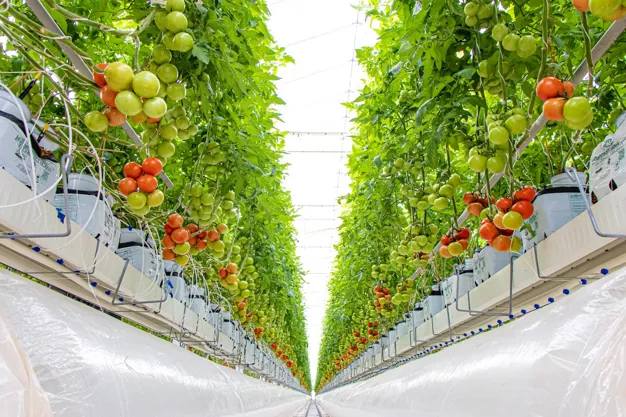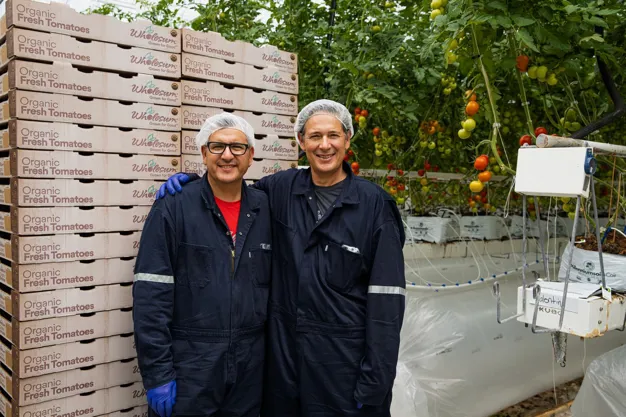Wholesum creates a consistent greenhouse climate in the heat of Arizona and Mexico
It's not coincidental that the second Ultra-Clima greenhouse finds its home with a grower unafraid to experiment. Fifteen years ago, the remarkable performance of the greenhouse caught the attention of Wholesum, an organic grower in the United States and Mexico.
Year-round cultivation in the summer heat was not an option in the past. Since then, KUBO has built Ultra-Clima greenhouses for the company in both Arizona (10 hectares) and Mexico (14 hectares). COO Theojary Crisantes says, 'Fifteen years ago, farming was much more trial and error than it is now.'

In the past fifteen years, the climate has become even more challenging, notes Theojary. 'At the end of September, we had a day with 37 degrees Celsius (98.6 degrees F) in Arizona. End of September! The conditions for cultivation are already extreme. In the winter, it can easily drop below freezing. And in the summer, it's forty degrees Celsius (104 degrees F) or more. In the past, we had to take a break in the summer because year-round cultivation was not possible.'
In search of a better greenhouse climate, Wholesum turns to a pad and fan system. This improves the growing conditions somewhat, but still not enough. Theojary says, 'We could regulate the climate a bit better, but we still couldn't achieve a consistent climate. This resulted in one part of the greenhouse being warmer than the other. When it came time to harvest tomatoes, there could be a week's difference.'
Gas supply by truck
A transitional step was the installation of fans in the greenhouse. At that time, fifteen years ago, an American colleague was already well advanced in experimenting in a semi-closed greenhouse: Casey Houweling, along with KUBO, the founder of the Ultra-Clima concept. 'Around that time, we began discussions with KUBO. We were intrigued by the initial results of the Ultra-Clima greenhouse. The main advantage was the ability to create a consistent climate. But the greenhouse also allowed us to reduce energy consumption. At that time, we didn't have an ideal gas supply. We didn't receive gas through a pipeline; it was delivered by truck. That was expensive.'
'Would it really work?'
The first greenhouse is built in Sonora Mexico, covering 2.5 hectare. 'One of the biggest uncertainties was whether it would really work. Removing heat from a greenhouse on hot, humid days is a significant challenge. But the results KUBO had achieved at Houweling gave us confidence.' The Results quickly proved encouraging at Wholesum as well, prompting an expansion of the Ultra-Clima area by another 2.5 hectares.

Steep learning curve
Theojary sees farming in the new greenhouse as a completely different profession. 'The Ultra-Clima greenhouse has a steep learning curve, and we're still learning every day. Back then, we didn't have the information sources that we have now. Farming was much more trial and error than it is today, with KUBO's Smart Growing. In the past, you had to do a lot of your own research, but now KUBO has the knowledge of the technology and farming.'
Wholesum’s Ultra-Clima greenhouse area has now grown to 24 hectares, spread across locations in the United States and Mexico. The next challenge is already within the greenhouse: after tomato cultivation, they are now transitioning to cucumber farming. 'That is a very different kind of cultivation. We've only been at it for ten months, and we can't say much yet.'
Organic grower
The company has been USDA Organic certified for thirty years. Wholesum also adheres to Fair Trade principles in its farming. The choice of the Ultra-Clima greenhouse aligns seamlessly with Wholesum's philosophy. Theojary says, 'It's a positive-pressure greenhouse with a single air inlet. This helps prevent insects from entering the greenhouse. Anything that can help prevent diseases and pests is a plus.'
Innovation continues
Despite farming in the world's most advanced horticultural greenhouse, Wholesum is ready for what’s next. Innovation continues at the family-owned company. Infrared cameras are used to detect temperature differences in the greenhouse, allowing for better climate control. The company is also investing in sustainable solutions. The use of solar panels is expected to make the company 75% self-sufficient in electricity needs. The installation of electricity meters in all parts of the greenhouse provides insight into exact power consumption.

These measures fit into Theojary's continuous search for optimal business operations. 'Are we there yet? Far from it. We've made about a hundred adjustments to tailor the Ultra-Clima greenhouse to our needs. Each location is different, and we will continue to make adjustments in the future. That's why the partnership with KUBO is so important. KUBO is a partner that listens to us well. It has been for years.
Taken from Hortidaily article - 12 December, 2023
